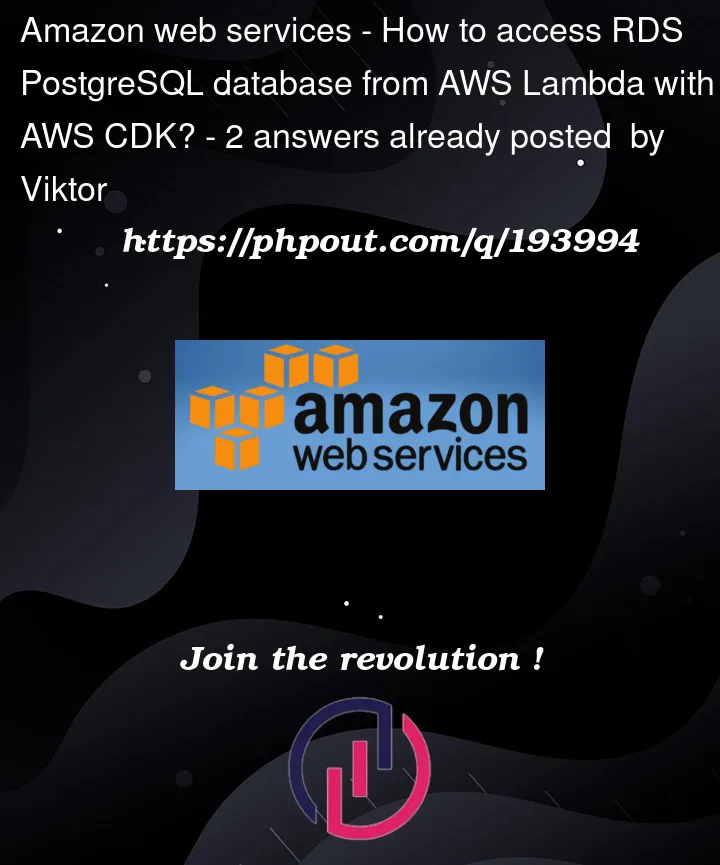I’m trying to build a stack using AWS CDK, which includes an RDS PostgreSQL instance and a Lambda function. From the Lambda, I’m trying to access the PostgreSQL, but I’m not succeeding in any way. My problem is that no matter what I do, I always get this error:
FATAL: no pg_hba.conf entry for host "IP", user "postgres",
database "codeSageVector", no encryption
Could someone help me figure out where the error is? I think it’s related to the security groups, but I have no clue. I’m starting to go crazy.
This is my Stack:
import * as cdk from 'aws-cdk-lib';
import {
aws_cloudfront as cloudfront,
aws_dynamodb as dynamodb,
aws_ec2 as ec2,
aws_events as events,
aws_events_targets as targets,
aws_iam as iam,
aws_lambda as lambda,
aws_lambda_destinations,
aws_rds as rds,
aws_s3 as s3,
aws_secretsmanager as secretsmanager,
Duration
} from 'aws-cdk-lib';
import { Construct } from 'constructs';
import { AccountRootPrincipal, AnyPrincipal, Effect, PolicyStatement } from 'aws-cdk-lib/aws-iam';
import { BlockPublicAccess, BucketAccessControl, ObjectOwnership } from 'aws-cdk-lib/aws-s3';
import * as path from 'path';
import * as cognito from 'aws-cdk-lib/aws-cognito';
import * as appsync from 'aws-cdk-lib/aws-appsync';
import { CustomStackProps } from '../types/custom-stack-props.type';
import { OriginAccessIdentity } from 'aws-cdk-lib/aws-cloudfront';
import { Peer, Port } from 'aws-cdk-lib/aws-ec2';
export class CodeSageStack extends cdk.Stack {
constructor(scope: Construct, id: string, props?: cdk.StackProps, customStackProps?: CustomStackProps) {
super(scope, id, props);
/**
* Postgres
*/
const postgresDatabaseName = 'codeSageVector';
// Create a VPC with 2 availability zones
const vpc = new ec2.Vpc(this, 'Vpc', {
maxAzs: 2
});
// Create a security group for the database
const postgresSecurityGroup = new ec2.SecurityGroup(this, 'postgresSecurityGroup', {
vpc,
allowAllOutbound: true
});
// Allow inbound traffic on port 5432 (PostgreSQL) from the VPC CIDR range
postgresSecurityGroup.addIngressRule(Peer.anyIpv4(), Port.tcp(5432));
// Create a secret for the database credentials
const postgresDbSecret = new secretsmanager.Secret(this, 'postgresDbSecret', {
generateSecretString: {
secretStringTemplate: JSON.stringify({
username: 'postgres'
}),
generateStringKey: 'password',
excludePunctuation: true,
includeSpace: false
}
});
// Create a PostgreSQL database instance
const postgresDb = new rds.DatabaseInstance(this, 'postgresDb', {
engine: rds.DatabaseInstanceEngine.postgres({
version: rds.PostgresEngineVersion.VER_15_2
}),
databaseName: postgresDatabaseName,
instanceType: ec2.InstanceType.of(
ec2.InstanceClass.BURSTABLE3,
ec2.InstanceSize.SMALL
),
vpc: vpc,
vpcSubnets: {
subnetType: ec2.SubnetType.PUBLIC
},
multiAz: false,
securityGroups: [postgresSecurityGroup],
credentials: rds.Credentials.fromSecret(postgresDbSecret),
allocatedStorage: 20,
storageType: rds.StorageType.GP2,
deletionProtection: false
});
/**
* CodeBase Bucket
*/
const codeBaseBucket = new s3.Bucket(this, 'code-base', {
removalPolicy: cdk.RemovalPolicy.DESTROY,
autoDeleteObjects: true,
eventBridgeEnabled: true,
cors: [
{
allowedHeaders: ['*'],
allowedMethods: [s3.HttpMethods.PUT],
allowedOrigins: [...(customStackProps?.s3?.codeBaseBucket?.allowedOrigins || []), `https://${distribution.distributionDomainName}`]
}
]
});
/**
* Lambda Layers
*/
const ulidLayer3_9 = new cdk.aws_lambda.LayerVersion(this, 'codeSageUlid3_9', {
layerVersionName: 'CodeSageUlid3_9',
code: cdk.aws_lambda.Code.fromAsset(path.join(__dirname, `../lambda/layers/ulid/`)),
description: 'A ULID is a universally unique lexicographically sortable identifier',
compatibleRuntimes: [cdk.aws_lambda.Runtime.PYTHON_3_9],
removalPolicy: cdk.RemovalPolicy.DESTROY
});
const psycopg2Layer = new cdk.aws_lambda.LayerVersion(this, 'codeSagePsycopg2Layer', {
layerVersionName: 'codeSagePsycopg2Layer',
code: cdk.aws_lambda.Code.fromAsset(path.join(__dirname, `../lambda/layers/psycopg2/`)),
description: 'Psycopg is the most popular PostgreSQL database adapter for the Python programming language',
compatibleRuntimes: [cdk.aws_lambda.Runtime.PYTHON_3_9],
removalPolicy: cdk.RemovalPolicy.DESTROY
});
/**
* Lambda Functions
*/
// Defines the CreateProject AWS Lambda resource
const createProjectFunctionSG = new ec2.SecurityGroup(this, 'createProjectFunctionSG', {
vpc
});
const createProjectFunction = new lambda.Function(this, 'CreateProject', {
runtime: lambda.Runtime.PYTHON_3_9,
code: cdk.aws_lambda.Code.fromAsset(path.join(__dirname, `../lambda/functions/create-project/`)),
handler: 'app.lambda_handler',
layers: [psycopg2Layer, ulidLayer3_9],
environment: {
APP_TABLE_NAME: appDynamoDbTable.tableName,
S3_CODE_BASE_BUCKET: codeBaseBucket.bucketName,
REGION: cdk.Stack.of(this).region,
POSTGRES_DB_ENDPOINT: postgresDb.dbInstanceEndpointAddress,
POSTGRES_DB_NAME: postgresDatabaseName,
POSTGRES_SECRET_ARN: postgresDb.secret?.secretFullArn || ''
}
});
postgresDb.connections.allowDefaultPortFrom(createProjectFunctionSG);
postgresDb.secret?.grantRead(createProjectFunction);
codeBaseBucket.grantReadWrite(createProjectFunction);
}
}
And this is my Lambda:
import os
import boto3
import logging
from datetime import datetime
import psycopg2
import psycopg2.extras
import psycopg2.sql
import json
region= os.environ['REGION']
postgres_db_endpoint = os.environ['POSTGRES_DB_ENDPOINT']
postgres_db_name = os.environ['POSTGRES_DB_NAME']
postgres_secret_arn = os.environ['POSTGRES_SECRET_ARN']
def lambda_handler(event, context):
secretManager = boto3.client('secretsmanager', region_name=region)
secretParams = {
'SecretId': postgres_secret_arn
}
dbSecret = secretManager.get_secret_value(**secretParams)
secretString = dbSecret['SecretString']
if not secretString:
raise Exception('Secret string is empty')
secretData = json.loads(secretString)
password = secretData['password']
conn = psycopg2.connect(
user='postgres',
host=postgres_db_endpoint,
database=postgres_db_name,
password=password,
port=5432
)
cursor = conn.cursor(cursor_factory=psycopg2.extras.RealDictCursor)
cursor.execute(psycopg2.sql.SQL('SELECT * FROM users'))
result = cursor.fetchone()
print(result['message'])
cursor.close()
conn.close()
return {
}
<!-- end snippet -->




2
Answers
The reason for the error was that SSL usage is mandatory for Postgre databases on AWS, and the Psycopg2 library I was using did not support SSL.
In the end, I used this library and it worked: https://github.com/anuragdev101/psycopg2
Suggesting to configure both the
vpcandvpcSubnetsof your function to make sure it gets access to the database.